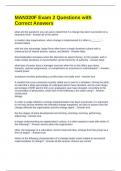MAN320F Exam 2 Questions with
Correct Answers
what are the questions you can ask to determine if a change has been successful on a
long-term level - Answer-all of the above
in modern day organizations, when change is implemented it is often a _______. -
Answer-failure
with the size advantage, larger firms often have a single dominant culture with a
universal set of shared actions, values, and beliefs - Answer-false
decentralization increases when the discretion to spend money, to hire people, and to
make similar decisions is moved farther up the hierarchy of authority - Answer-false
what type of power does a manager exercise when he or she offers pay raises,
bonuses, special assignments, or compliments as incentives to subordinates? - Answer-
reward power
avoidance involves pretending a conflict does not really exist - Answer-true
A student from your university recently called you to ask for a donation. During the pitch,
he said that a large percentage of undergrad alumni have donated, and an even larger
percentage of BHP alumni from your graduation year have donated. According to the
six principles of persuasion, which two of the following is the caller using? - Answer-
social proof
linkage
In order to judge whether a change implementation has been successful, it is important
to not only assess whether the intended change happened, but also to assess how the
change affected the organization and the change agent. - Answer-true
the five stages of team development are forming, storming, norming, performing,
adjourning - Answer-true
to begin understanding an organization's culture, it is often easiest to start with which of
the following? - Answer-stories about the organization
often, the language of a subculture, and its ritual and rites, emerge from the group as a
form of jargon. - Answer-true
Which of the following characteristics of a change leader is/are related to successful
implementation of change? - Answer-all the answer choices are correct
, An essential criterion of a true team is that the members feel 'collectively accountable'
for what they accomplish. - Answer-true
team performance is not in danger of suffering when: - Answer-goals are well designed
Team cohesiveness tends to be low when members are similar in age, attitudes, needs
and backgrounds. - Answer-false
the system of shared actions, values, and beliefs that develops within an organization
and guides the behavior of its members is called an organization culture - Answer-true
A product divisional form of departmentalization is the best organizational structure for a
company that produces only one product but sells it in numerous geographical
locations. - Answer-false
high performance teams turn a general sense of purpose into specific performance
objectives - Answer-true
when issues are more important to others than to yourself or when you want to build
'credits' for use in later disagreements, _______ ,may be used - Answer-
accommodations
unfortunately, given its origin from the founder's values, managers cannot modify the
visible aspect of culture, such as language, stories, rites, rituals, and sagas - Answer-
false
The top management of the Greenbucks Hills Coffee Company has just decided to
serve beer and wine after 5pm at its 3000 retail outlets in the US, in response to a
perceived opportunity to attract customers between work hours and dinnertime. This is
an example of which of the following types of change? - Answer-proactive change
____ set the tone for culture and culture change - Answer-top managers
with regards to decision-making, what should the best teams do? - Answer-not limit
themselves to just one decision-making method, using it over and over again regardless
of circumstances
Interestingly, strong subcultures are seldom found in high-performance task-forces,
teams and special project groups in organizations. - Answer-false
Which of the following statements is incorrect regarding subcultures? - Answer-
Subcultures reflect groups with a unique pattern of values and philosophy that are
inconsistent with dominant culture of the larger organization or social system.
values, underlying assumptions, and deep beliefs, make up the ___ component of an
organization's culture - Answer-invisible




